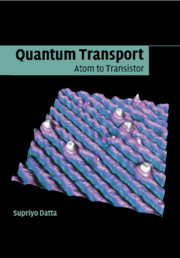Book contents
- Frontmatter
- Contents
- Preface
- Acknowledgements
- List of symbols
- 1 Prologue: an atomistic view of electrical resistance
- 2 Schrödinger equation
- 3 Self-consistent field
- 4 Basis functions
- 5 Bandstructure
- 6 Subbands
- 7 Capacitance
- 8 Level broadening
- 9 Coherent transport
- 10 Non-coherent transport
- 11 Atom to transistor
- 12 Epilogue
- Appendix: advanced formalism
- MATLAB codes used to generate text figures
- Further reading
- References
- Index
Preface
Published online by Cambridge University Press: 05 June 2012
- Frontmatter
- Contents
- Preface
- Acknowledgements
- List of symbols
- 1 Prologue: an atomistic view of electrical resistance
- 2 Schrödinger equation
- 3 Self-consistent field
- 4 Basis functions
- 5 Bandstructure
- 6 Subbands
- 7 Capacitance
- 8 Level broadening
- 9 Coherent transport
- 10 Non-coherent transport
- 11 Atom to transistor
- 12 Epilogue
- Appendix: advanced formalism
- MATLAB codes used to generate text figures
- Further reading
- References
- Index
Summary
The purpose of this book is to convey the conceptual framework that underlies the microscopic or atomistic theory of matter, emphasizing those aspects that relate to electronic properties, especially current flow. Even a hundred years ago the atomistic viewpoint was somewhat controversial and many renowned scientists of the day questioned the utility of postulating entities called atoms that no one could see. What no one anticipatedwas that by the end of the twentieth century, scientistswould actually be “seeing” and taking pictures of atoms and even building “nanostructures” engineered on a nanometer length scale. The properties of such nanostructures cannot be modeled in terms of macroscopic concepts like mobility or diffusion. What we need is an atomic or microscopic viewpoint and that is what this book is about.
The microscopic theory of matterwas largely developed in the course of the twentieth century following the advent of quantum mechanics and is gradually becoming an integral part of engineering disciplines, as we acquire the ability to engineer materials and devices on an atomic scale. It is finding use in such diverse areas as predicting the structure of new materials, their electrical and mechanical properties, and the rates of chemical reactions, to name just a few applications. In this book, however, I will focus on the flow of current through a nanostructure when a voltage is applied across it. This is a problem of great practical significance as electronic devices like transistors get downscaled to atomic dimensions.
- Type
- Chapter
- Information
- Quantum TransportAtom to Transistor, pp. ix - xiPublisher: Cambridge University PressPrint publication year: 2005

